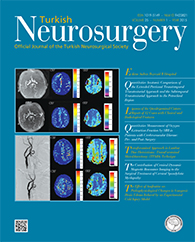Turkish Neurosurgery
2015 , Vol 25 , Num 1
Spontaneous Angiographic Regression of Cerebral Arteriovenous Malformations: Angiographic Disappearance is not the Real Cure
Nippon Medical School, Department of Neurosurgery, Tokyo, Japan
DOI :
10.5137/1019-5149.JTN.9579-13.4
Angiographically occult arteriovenous malformations (AOAVMs) are poorly understood. AOAVMs include spontaneous regression of cerebral
AVMs. Here we discuss spontaneous angiographical regression of cerebral arteriovenous malformations (SRAVM). We present the case of
a 34-year-old male patient with SRAVM in whom an arteriovenous (AV) shunt remnant was revealed by intraoperative indocyanine green
videoangiography (ICG-VAG). Preoperative angiography indicated spontaneous regression of AVM. We reviewed the literature for articles
having specific citations or case histories of SRAVMs. On the basis of our ICG-VAG findings, we confirmed the possibility of an AV shunt remnant
being present in patients with SRAVMs. In addition to our own case, we reviewed previously reported cases and analyzed the data from 132
patients with SRAVMs. Ninety-five (72%) such patients received conservative therapy without surgical removal, and 37 (28%) were treated
surgically. Only three patients in whom an SRAVM recanalized after 39, 31, and 16 months have been reported. The rate of recanalization in
SRAVM including 3 previously reported cases and the present case, is 3.0% (4/132). Intraoperative ICG-VAG can reveal more SRAVMs that
recanalize within a short period even if AV shunts are not depicted by angiography. Therefore, surgical removal of the AOAVM should be
considered in cases with low surgical risk.
Keywords :
Arteriovenous malformation, Angiographically occult, Indocyanine green videoangiography, Spontaneous regression





